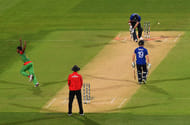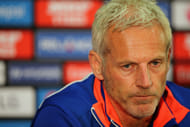As soon as James Anderson, England’s number XI, walked in with the penultimate over of the chase in progress, the imminence was in the air. There was only one possible outcome. More than the 16 runs England needed to score off the remaining deliveries, the number that mattered was ‘one’.
Failure to survive
Could Jimmy Anderson survive one ball, and if we weren’t pushing it, rotate the strike off it too? Chris Woakes at the other end was doing a tremendous job with the bat. They still hoped. Stuart Broad while walking off had even warned Anderson to be cautious of the reverse movement the Bangladesh bowler was extracting.
Now, tricking the batsman into deception through the art of reverse swing is one thing. Anderson has mastered the craft. But you don’t really expect him to spot the inverted shine and rotate the strike off it, do you? Much less in a knockout situation, with quite possibly the entire team management’s fortune hanging in jeopardy.
But Anderson survived. The ball from Rubel Hossain was tailed in full, angling away from the left-hander. There was a sharp knick to an attempted yorker, but there was a slip placed in that cordon anticipating the edge. No runs scored. England were still in it.
However, it didn’t take the bowler too long to realize Anderson completely lacked the confidence in his ability to change ends, and that a delivery dropped full and straight would be enough to rattle through his defence. Which is exactly what happened next.
Rubel changed the line of attack. The next delivery was pitched in the slot on middle-leg. Finding himself in the 11th hour, Anderson had little choice but to play it across the line towards the mid-wicket region and run for his life. Predictably, he failed to connect and off flew the bails.
Anderson dismissed, England eliminated
With that, much more than Anderson’s middle stump stood was destroyed – and in no small part due to England’s fundamentally flawed approach to ODI cricket or perhaps, as Kevin Pietersen would assert, to cricket in general.
Now, unless you’re lost in a parallel space-time continuum, deprived of internet connectivity, you’d have certainly read about England head coach Peter Moores’ first reaction to the defeat. His remarks have been a subject of public mockery ever since and with good reason.
Twitter is flooded with memes and wisecracks. Michael Vaughan has reacted. So has Pietersen. Notable members of the Sky broadcasting team such as David Lloyd and Michael Atherton, otherwise unpopular for their pro-establishment stance, have also been vocal in their criticism.
So what was so unpardonably wrong in what Moores said? He merely hinted at the need to verify the data that led them to believe the target was achievable. Fair enough, isn’t it? Most teams these days avail services of professional data analytics agencies whose job is to crunch numbers beyond the routine understanding, and finding patterns by applying several meticulously designed statistical tools on them. In essence, data is numbers in their most raw form.
The job of a statistician is to observe patterns and extract certain information from the data to help devise strategies, or at least create an illusion of the numbers aiding to achieve the ends. Data churning is part of the modern cricket culture and is even more elaborately practiced in other sports.
So why crucify Moores and England for doing something entirely common and acceptable in the cricketing community at large?
Data is fine, but to what extent?
Well, for starters, they overdid it. For all the statistical scrutiny of players and team tactics, the game is still played on the field and not on tele-simulators. The rigorous efforts behind processing the data often overstate the importance of the entire exercise. While they may provide an invaluable insight from time to time, it’s important to realize the sport still remains human in nature. And if there’s one thing you need to know about humans, it’s that they’re annoyingly unpredictable.
The scientifically processed data may tell you Mitchell Johnson ‘tends to’ bowl one full after banging in three deliveries dangerously short of length. He does have a reason to do that, since batsmen tend to hang back in the crease against a barrage of bouncers and are more than likely to knick one pitched surprisingly up, playing with soft hands. But the moment the batsman starts anticipating one full delivery by relying on what has been recommended by the backroom staff, is where the trouble begins.
No evidence is sufficiently verified for players to start entertaining the predicted scenarios with certainty. Over-reliance on data will more than likely lead to disaster, and England have scripted their own disaster by refusing to admit the failure of the system.
Whether it is the fear instilled from Johnson’s thunderbolts during the last Australian summer or another ill-founded piece of advice to play more percentage shots from the crease, the English batsmen do not lean forward. Feet movement is minimal, and the tendency to throw their bats with hard hands against anything pitched up has rather easily done them in.
Now, these are the faults that merit the coach’s attention. These are the faults that need to be examined and corrected in the nets. But one suspects that in the numbers-driven environment, England may not have got their priorities right.
Weeks before the World Cup, England appointed Eoin Morgan as the captain of the ODI side, replacing the beleaguered Alastair Cook. The southpaw of Irish origins was expected to bring freshness to the team’s approach and recalibrate England’s tactical nous to modern day cricket. But much like his predecessor, Morgan in his captaincy has failed to emulate Michael Clarke’s instinctive spontaneity, Brendon McCullum’s courage or MS Dhoni’s control.
England didn’t learn from previous experiences
In a high-pressure, must-win game at Adelaide, England opted to put Bangladesh into bat. As confirmed by Moores in his post-match media interaction, they did back themselves to chase any competitive total. Certainly, the numbers played an influential role in arriving to that conclusion. What’s surprising to note here though is that England chose to overlook the fact that their batting has hardly ever delivered under pressure in a big tournament knockout game – which is exactly what they put the batsmen under by opting to chase.
Of course, the Bangladesh pacers did a fabulous job bowling with a decent seam position and finding the right amount of reverse at the death. But that cannot mask England’s tactical shenanigans.
At multiple occasions in the tournament, the captain and the bowlers allowed the game to drift away from a position of potential dominance. Strike bowlers pitched inexplicably short, their alternatives being too straight, and Moeen Ali was never expected to be a threat on these wickets – he’s still done a fairly good job though.
It makes you wonder how not one among the array of England’s coaching staff pointed out these basic errors, and how those in charge could have failed to detect the dire need to modernize the tactics to suit ODI cricket of the present age.
Eminent names in the English press have pointed fingers at constantly restructuring the format of the domestic List A tournament, to the packed schedule of the domestic season and to the lack of participation in the domestic game by those playing for England. But then, Dhoni and Virat Kohli are hardly names you spot playing in the Vijay Hazare trophy either.
Where do England go from here?
It’s not always as simple as critics might want to think. England have all the necessary resources and infrastructure to revive their fortunes in the format they were the first to envisage, but the need of the hour is to lose the intransigence. The ODI landscape has changed drastically over the last decade and while it’d be unfair to say England have been completely off the pace, it’s evident that they haven’t kept up to the pace either.
Sporadic success in ODIs has even led them to the summit of the ICC rankings but on the big stages, they’ve been only slightly more than pushovers. Perhaps somebody like Paul Collingwood – their most-capped ODI player of all time – could be given a more definite role in the coaching set-up, and equip them with the correct mindset and approach to be competitive in limited overs cricket.
Perhaps all they need is to play the 50 overs game in the right frame of mind. That doesn’t guarantee instant success of any sort, but at this stage, England shouldn’t mind the tiniest of steps in the right direction. After all, it’s hard to fall further down from here.
Follow IPL Auction 2025 Live Updates, News & Biddings at Sportskeeda. Get the fastest updates on Mega-Auction and cricket news


